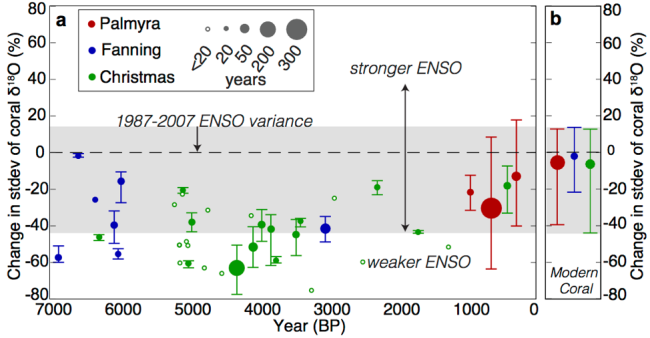Coral reconstructions of central tropical Pacific climate suggest a 25% increase in recent El Niño Southern Oscillation intensity
Recent observations showed that intensities of the El Niño Southern Oscillation (ENSO) were highly variable, thus raising the question whether or not this apparent intensification is significant and related to human-induced global warming. ENSO cycles are one of the most studied climate phenomenon, but yet our understanding of how they are changing in a world with enhanced greenhouse gas concentrations is not clear. CMIP5 climate models predict a robust increase in ENSO variability in a world with higher carbon dioxide concentrations, meaning that extreme El Niño events, such as those in 1997/98 and 2015/16, could occur more frequently. Paleo reconstructions of historical ENSO events, however, provide a critical baseline to compare with contemporary observations.

In a recent article published in Geophysical Research Letters, Grothe and others compiled monthly records of ocean surface temperature over the last several millennia using fossil coral oxygen isotopes from the Line Islands, central tropical Pacific. This is the most comprehensive Line Islands fossil coral dataset to date, adding over 200 years of new data for a total of almost 1,500 years of regional ocean surface temperature records spanning over the last 7,000 years. The authors measured the changes in ENSO intensity by first removing any long-term trend that may bias the records, as well as the seasonal cycle, and then measured the resulting spread relative to the mean in 20-year windows. Comparison of the fossil corals samples with modern corals showed that the recent intensification was quite apparent – the most recent 20 years was stronger than almost all 20-year periods measured over the entire preindustrial fossil coral dataset. In all, ENSO intensity has strengthened by 25% over the last 30 years compared to the preindustrial period.
The authors assessed the significance of their results by replicating the exact coral dataset using state-of-the-art time-series of ENSO cycles. Using a Monte Carlo statistical method, the exact number and length of corals used in the reconstruction were extracted from long unforced time-series and similarly compared as the preindustrial and industrial coral dataset. After running the analysis 10,000 times, the simulation results indicated that the observed 25% increase in ENSO intensity was significant. More work is needed to identify the underlying response of ENSO to global warming, but this study highlights some of the first evidence that ENSO variability may already be intensifying due to greenhouse gas emissions. The authors do note that there is an observable freshening trend in the central tropical Pacific, but that this change is too small to account for the large increase in ENSO intensity.
Enhanced El Niño‐Southern Oscillation variability in recent decades (Geophysical Research Letters)
Topics
- Paleo
- ENSO
